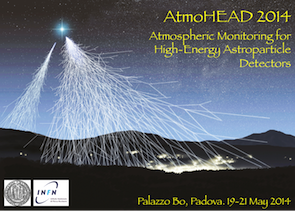Speaker
Mr
Stefan Kimeswenger
(Universidad Catolica del Norte, Antofagasta, Chile / University Innsbruck, Austria)
Description
A large fraction of uncertainty for the interpretation of data from imaging Cerenkov telescopes originates from the use of static average atmosphere models. We present an alternative approach to this issue.
As part of the entrance fee to the European Southern Observatory (ESO) Austrian universities developed software modules for various projects, called in-kind projects, dealing with the effect of the Earth's atmosphere on ground-based astronomical observations. The Innsbruck team (http://www.uibk.ac.at/eso) has provided tools to calculate this influence of the atmosphere for the astronomical community (https://www.eso.org/observing/etc/skycalc/skycalc.htm; Noll et al. 2012, A&A, 543, A92, Kausch et al. 2014, arXiv, 1401.7768). In the framework of the follow up programs, the team now extends the applications to geoscience (Jones et al. 2013, EGUGA, 15, 8478; Kausch et al. 2013, EGUGA, 15, 7425), and other astronomical fields. In particular, the adaption of these tools to air shower experiments looks promising.
The software is based on the radiative transfer code LBLRTM (http://rtweb.aer.com/lblrtm.html) for molecular absorption and our own elaborate code aimed for calculating the scattering of the continuum (including local sources e.g. ground reflection). For information on the molecular line parameters, the HITRAN data base (http://www.cfa.harvard.edu/hitran) is used. In addition, atmospheric profiles based on a standard atmosphere and the Global Data Assimilation System (GDAS) weather models obtained from the National Climatic Data Center (NOAA; http://www.ncdc.noaa.gov/) are incorporated. We also compared our results with data obtained with the Low Humidity and Temperature Profiling microwave radiometer (LHATPRO; for details see Kerber et al. 2014, doi:10.1093/mnras/stt2404) profiles.
Recently, dedicated observations of scattered moonlight with the ESO VLT have been taken to study aerosol scattering in more detail (Jones et al. 2013, A&A, 560, A91; 2014, in prep). The ESO site at Cerro Paranal was perfect for the study, as it provides many different sources of information to improve the model, e.g. local meteorological information, as well as radiometer data, and high resolution astronomical spectra containing the finger print of the state of the Earth’s atmosphere. Although these investigations are based on Cerro Paranal data, the deep understanding of the connection between the GDAS models and local calibrators can also be applied everywhere.
Imaging atmospheric Cherenkov telescopes like MAGIC and HESS are dominated by the effects of the lower 10km of the atmosphere and are working at the very blue end of the spectrum until the ozone absorption. Recently, the molecular data base HITRAN was extended into this blue domain.
The talk shows the status of the current research and the existing tools and discusses how information from various other calibrators (stars, radiometers, …) can be included into the model optimisation. Furthermore, we discuss how radiation generated in the lower atmosphere can be handled. This opens the discussion about which adaption of such models, originally designed for optical/IR light sources from outer space, can be applied in the case of the atmospheric Cherenkov telescopes and which kind of calibrators are useful to obtain better results than general static profiles mostly used up to now in the astro-particle community.
Author
Mr
Stefan Kimeswenger
(Universidad Catolica del Norte, Antofagasta, Chile / University Innsbruck, Austria)
Co-authors
Amy M. Jones
(Institute of Astro and Particle Physics, Innsbruck)
Stefan Noll
(Institute of Astro and Particle Physics, Innsbruck)
Stefanie Unterguggenberger
(Institute of Astro and Particle Physics, Innsbruck)
Wolfgang Kausch
(Institute of Astro and Particle Physics, Innsbruck & Institute of Astrophysics, Vienna)

